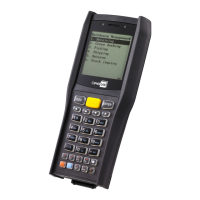
Do you have a question about the CipherLab 8400 and is the answer not in the manual?
| Brand | CipherLab |
|---|---|
| Model | 8400 |
| Category | Mobile computer |
| Language | English |
Explains the main and backup batteries, their charging, and status monitoring.
Details ROM, RAM, and SD card storage options and their usage.
Describes the 29-key and 39-key keypad layouts and their functionalities.
Information on the graphic LCD display, resolution, and font options.
Explains the status LEDs and their meanings for charging and communication.
Covers supported barcode symbologies for 1D CCD, 1D Laser, and 2D scan engines.
Details USB and RS-232 interface cables, as well as various cradle options.
Information on accessing and managing files on an SD card, including file systems and directory structure.
Covers software packages like FORGE Application Generator and MIRROR Emulator for app development.
Explains the core system components: System Menu, Kernel, and Program Manager for device management.
Provides important system information like hardware and software versions for diagnostics.
Allows users to change default settings for clock, backlight, contrast, and other system parameters.
Details functional tests for key components like reader, buzzer, LCD, and keyboard for verification.
Provides information on memory types (RAM, Flash) and initialization functions for data management.
Shows current voltage consumption for main and backup batteries to monitor power status.
Explains how to load C, BASIC programs, or font files via different interfaces for software installation.
Guides configuration of Bluetooth settings for connecting and communicating with other devices.
Covers using the mobile computer with an SD card as a removable disk for data storage and access.
Instructions for establishing an Ethernet connection using the Ethernet Cradle for network connectivity.
Details establishing a PPP connection via the Modem Cradle for internet access over serial links.
Configuration of 802.11b/g wireless networking parameters for Wi-Fi connectivity.
Manages multiple applications and languages, allowing storage of up to eight programs and activation.
Explains the kernel's role in system security and recovery when other menus fail, for critical system maintenance.
Lists wireless capabilities like Bluetooth Class 2 and 802.11b/g for different models.
Details the types of barcode readers supported, such as CCD and 2D imagers.
Covers battery, power adapter, and operating temperature specifications for device operation.
Outlines CPU, memory, display, keypad, and indicator specifications for device components.
Specifies operating and storage temperature, humidity, and impact resistance for device durability.
Lists development tools and software utilities for programming applications on the device.
Lists optional accessories such as protective covers and battery chargers to enhance device functionality.
Details the types of files that can be downloaded: font, AG runtime, kernel update, and BASIC program.
Instructions for downloading font files (.SHX) via System Menu or Kernel Menu.
Guides downloading C programs (.SHX) via System Menu, Program Manager, or Kernel Menu.
Explains downloading BASIC runtimes and programs (.SYN) to enable BASIC application execution.
Steps to resolve issues when the device does not power on, focusing on battery and charging.
Troubleshooting steps for charging errors, including battery and cable checks for proper power delivery.
Steps to diagnose and fix issues with the buzzer not working, involving tests and battery reloads.
Troubleshooting steps for non-functional LED indicators, involving tests and battery reloads.
Steps to resolve problems with the LCD display not working, involving tests and battery reloads.
Troubleshooting for issues with the keypad not responding, involving tests and battery reloads.
Steps to address problems with the vibrator not functioning, involving tests and battery reloads.
General troubleshooting for the mobile computer not working correctly, involving data upload and memory tests.
Solutions for barcode scanning failures, including low battery, reader issues, and dirty scan windows.
Troubleshooting steps when data cannot be decoded after scanning, focusing on barcode quality and scanner programming.
Tips for resolving issues related to the scanning range by adjusting distance.
Guides for troubleshooting data transmission and reception problems via RS-232, USB, Bluetooth, and Wi-Fi.
Default key assignments for the 29-key keypad layout, showing blue and orange key functions.
Details on extended function keys and how they are mapped to alphanumeric and numeric inputs.
Default key assignments for the 39-key keypad layout, showing blue and orange key functions.